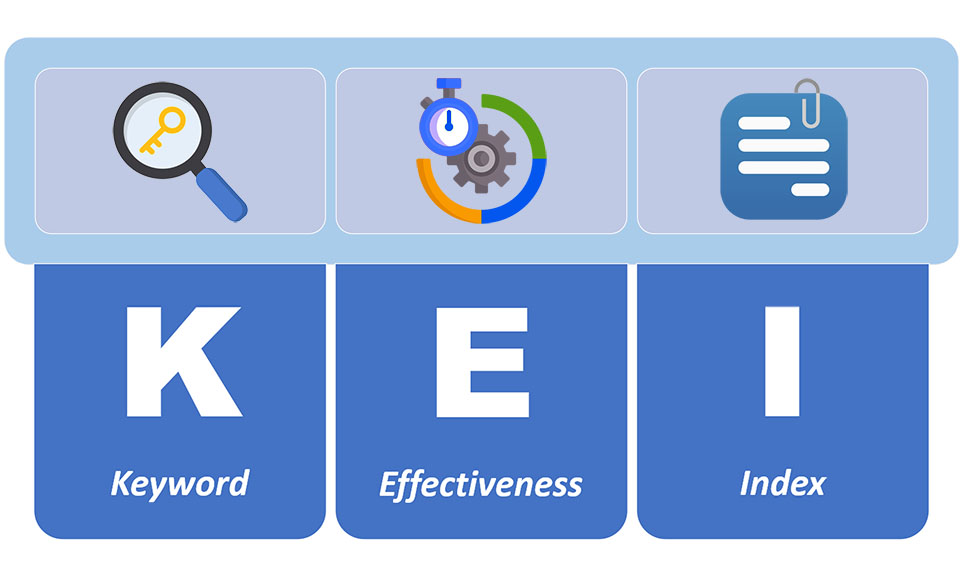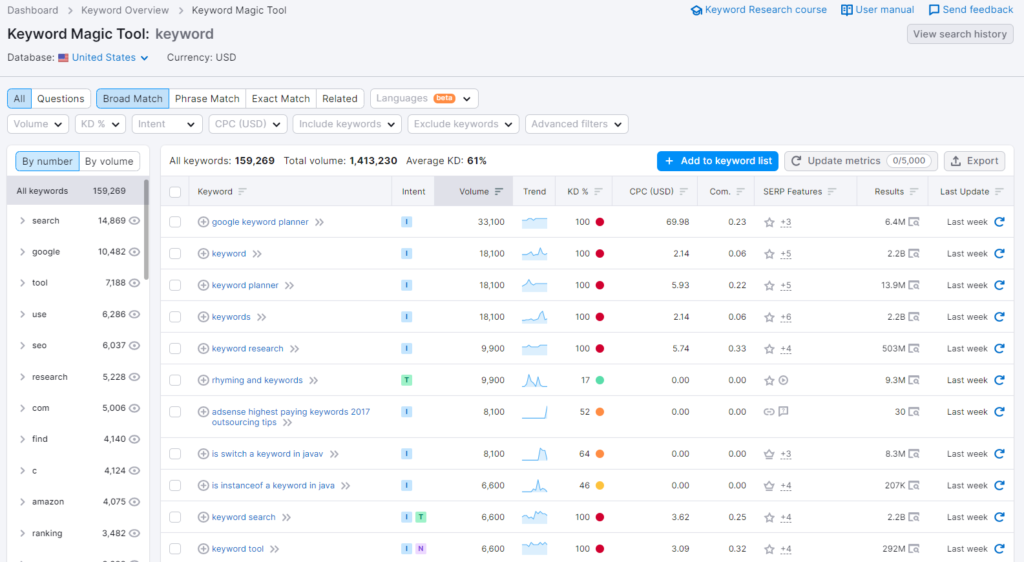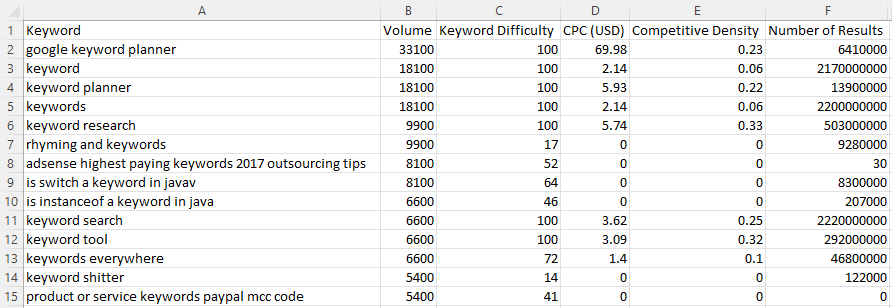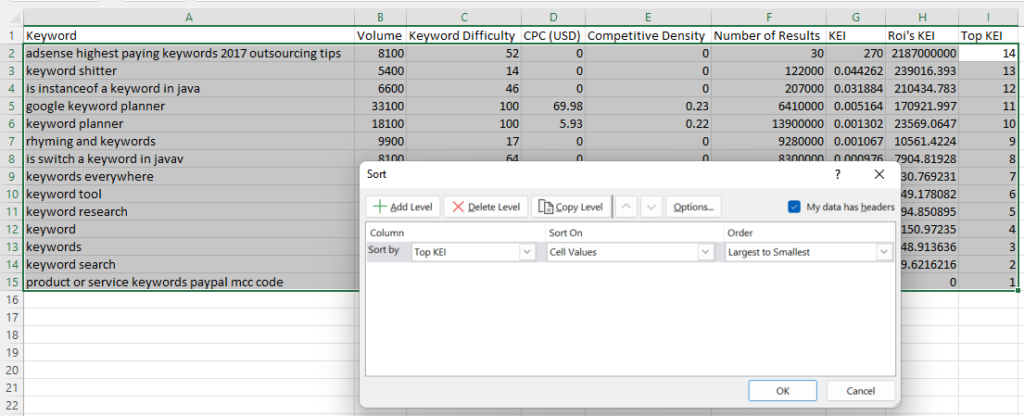
What is the real formula for Keyword Effectiveness Index (KEI)?
There are many versions of this formula, but in general, it is the ratio between search volume and some competition metric or keyword difficulty metric. It is often expressed as a fraction where:
KEI = Search Volume / Competition
Keywords with a higher KEI help you prioritize the keywords you would want to target first because you are getting the best balance between keywords that are searched the most with the least amount of competition.
The original formula for KEI, when it was first mentioned online by Sumantra Roi who created this for one of the pioneer keyword research software WordTracker, was:
KEI = (P^2/C)*1000
In his formula, P was the popularity of the keyword which is essentially Search Volume, and C was the competition metric, where Roi used the number of search results.
Breaking this formula down, it is still search volume over competition. And since the search volume is in the numerator of the fraction, it is directly proportional to KEI, while the competition is in the denominator which is inversely proportional to KEI.
This simply means as search volume increases, KEI increases. And as competition decreases, KEI still increases.
Roi’s original formula squares the search volume, and then multiplies everything by 1000 to adjust the number to make it more “readable.” This avoids getting values that are lower than 1 with many decimal places.
You can also use your own formula, as long as the search volume is in the numerator and competition metric is in the denominator. Assuming the latter is followed, you can then multiply any factor to it to make the number more readable to people that may use your formula.
How do you use KEI? Do I disregard low KEI keywords?
Basically KEI will be one of the metrics you will use in selecting the keywords you wish to target and prioritize as a part of your initial optimization strategy.
When KEI is low, it can mean 3 things:
- Search volume is very low.
- Competition or keyword difficulty is very high.
- Both search volume is low and competition is high.
Just because search volume is low does not always mean the keyword is not a good keyword to target. I’ll talk more about this in our next blog post on search volume. While a keyword with high competition or difficulty to rank does not mean you should not target the keyword, it just means that it will take more time and more work to rank relative to the other keywords.
How to set up a simple KEI formula in Excel or Google Sheets
In any keyword research tool, keywords will give you search volume. Different tools may have different numbers based on how they obtain search volume values, but that is not the main topic of discussion. As long as there is a search volume metric, you can use that and save it to one column. And for the competition metric, there are several metrics you can use, and I will let you decide on what you believe is best for you. Using one of the many keyword research tools you can use, below is a screenshot of SEMRush’s Keyword Magic Tool when I entered the word: “keyword”.

The search volume metric, they simply label as Volume.
For the competition metric, you have the option to use KD % which is Keyword Difficulty coming from the Moz API. CPC and Com are the Cost Per Click and Competition metrics respectively coming from Google’s Keyword Planner from the Google Ads API, and the Results metric is the number of search results that appear in Google when you search for the keyword. All these competitor metrics are valid to use for a KEI formula. They may come from different sources and be defined differently, but something common across them is that as the value increases, the harder it is to rank for the keyword.
Exporting this list as a CSV, Excel file, and opening it up in Excel or Google Sheets, you end up with something like this:

Other exported columns were deleted and 15 rows were maintained (14 keywords+header row) for demonstration purposes. At the right of the table, you can add a column and label it KEI, and simply divide the volume column by one of the competitor metrics. For now I will use the number of results.
In the screenshot below, cell G2, has the formula:
=B2/F2

One thing you will notice is that most of the KEI values are below zero, and some are using scientific notation. Look at the second keyword as it has a KEI of 8.43E-06, which means 8.43 x 10-6 or 0.000000843.
Since it is hard to read which numbers are higher or smaller, it makes sense to me why Roi squared the search volume to make it a larger number, moving it further away from the Number of Results metric that can sometimes reach into the millions. To shift the decimal place 3 digits to the left, he multiplied it by 1,000. Applying this in the spreadsheet you get this:

In cell H2, I added:
=((B2^2)/F2)*1000
Note that grouping symbols, or the parenthesis, are important in the order of operations. Not using them could give you an incorrect computation of KEI.
On line 15, KEI has a value of #DIV/0! which is an error because mathematically you cannot divide a number by zero. Using the IFERROR formula in Excel can help clean this up and enable you to use the KEI value in other formulas if you need it. Lastly, you need to wrap the current KEI formula in IFERROR and give the new value if an error occurs. In our example, let’s just make all KEI errors into zero.
So G2 turns into: =IFERROR(B2/F2,0)
And H2 turns into: =IFERROR(((B2^2)/F2)*1000,0)
After applying the same formula to all rows, the error will disappear. If I still had all 50k rows in this original export, there would be tons of errors if this formula was not applied.

From here, you can replace the number of results (column F in this example) with any of the other competition metrics (columns C to F). And when you do that, you will see, you do not always need to square the search volume and/or multiply it by 1,000. Which is why I don’t apply ROI’s KEI formula, and I simply divide search volume by the competition metric of my choice. But to make it easier to read, I will use Excel’s RANK formula to rank all of these to find the top KEI to lowest KEI.

The Top KEI column gives a rank number and simplifies it to make it easier to read. The formula in I2 is:
=RANK(G2,$G$2:$G$15,1)
This just says, among all the KEI in column G from rows 2 to 15, and ranking them where the lowest KEI is 1, what is the rank of G2.
Applying this, you can see the keyword with the highest KEI is 14, and the one with the lowest KEI is 1. If these were rows of 50,000, it can be harder to view, but you can use Excel’s sorting tools to sort it from highest to lowest.

The advantage of the RANK formula is you do not need to use any factor to be multiplied to KEI to adjust the decimal point and make it more readable. The disadvantage of it is you do not get to have a sense of intensity or amplitude for how far the true KEI values are from each other. But in my opinion, KEI is not intended to be used to know which keyword is truly better than another. KEI is used to help prioritize which keywords to target first. And if that is the case, all you need to know is the KEI rank.
Is KEI important? Do I need to use KEI?
Using or not using KEI will not necessarily help your ranking. You can still perform well in SEO without knowing what this is. In fact I personally know many SEO people I’ve worked with in the past that do not bother looking at KEI or computing this value, but they are still successful in their SEO campaigns.
Having said that, do I even still need KEI?
In my opinion, it is still advantageous if you do use it. SEO can sometimes take time to see significant results. And you may have a good understanding of this, but other stakeholders, like your SEO clients, or if you work in-house as the resident SEO, your employer may be anxious to see the benefits of SEO right away. And if that is the case, you would always want to get the low hanging fruit, to be able to show results as soon as possible.
KEI is not a score metric to decide which keywords to target and disregard. It is a score metric to help decide which keywords to prioritize first. So that you get the greatest bang for your buck at the soonest possible time as you continue to optimize for the rest of the keywords that could take more time to see results.
Written by Benj Arriola
Senior Director SEO @ 85SIXTY



